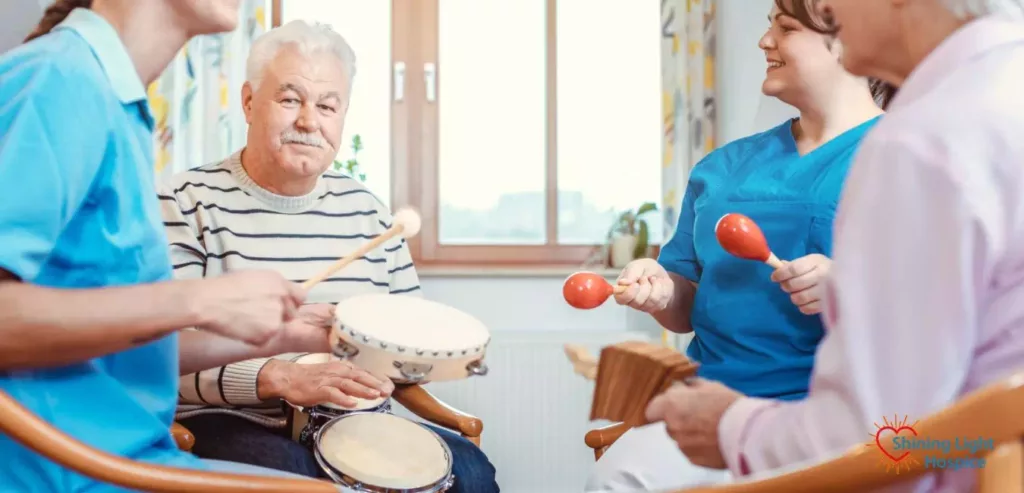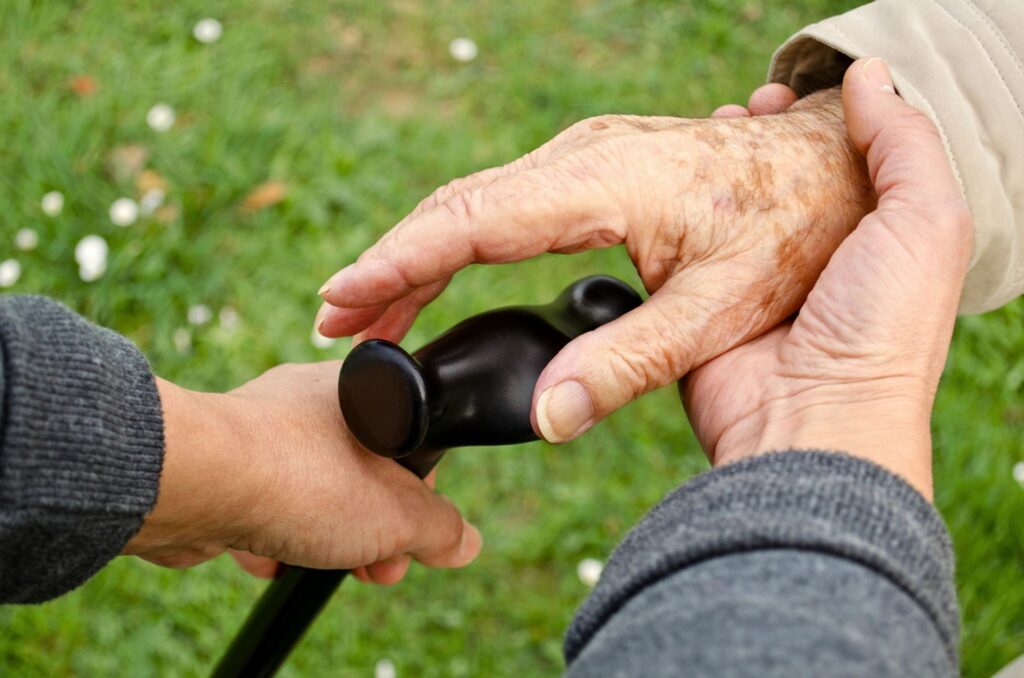Hospice for ALS Patients
Amyotrophic Lateral Sclerosis, ALS, is also known as Lou Gehrig’s disease. Though not as common as some other diseases, it still accounts for approximately 6,000 new diagnoses per year in the US. As there is no cure for it, once symptoms have progressed into late stages, hospice care for ALS is the best option to maintain patient comfort.
What Is ALS?
The ALS Association defines the condition as: a progressive neurodegenerative disease that affects nerve cells in the brain and the spinal cord. The disruption to the nerve cells that control motor function causes the eventual breakdown in voluntary muscle movement. Basically, the brain loses connection with the affected muscles causing weakness, and the loss of movement. Eventually, ALS patients will lose their ability to move, swallow, and even breathe.
The average lifespan after diagnosis is 2-5 years, however it is fatal in all cases. The progressive degeneration affects patients differently, therefore, the exact course of the disease is unique to the individual. Typically the symptoms are gradual in onset. Here is a general overview of the disease and the benefits of hospice care for ALS.
Who Gets ALS?
The age group most affected by this condition is 40-70 year olds and the average age is 55. Caucasions, men and military personnel are at a higher risk of having ALS. In the US, greater than 60% of patient diagnoses are in males, and over 90% are Causasian. The exact causes of the disease are still unknown and may include risk factors such as family history of the disease, environmental exposures, and previous viruses.
Five Types Of ALS
For ease of diagnosis and understanding, ALS is classified into five types.
Classical ALS
The most prevalent form of ALS is the Classical form. It accounts for greater than two thirds of all ALS patient diagnoses. Patients who have this condition have no previous family history of the disease. With this form, it is suspected that an abnormal processing of proteins, chemical imbalances, or an improper immune response results in the cascade of upper and lower muscle nerve cell destruction. The average age at onset of symptoms of Classical ALS is 55.
Primary Lateral Sclerosis
Primary Lateral Sclerosis (PLS), is the rarest known form of the disease. Upper motor neurons are primarily affected and if no lower motor neuron destruction occurs within two years, then it will likely be limited to upper motor neuron involvement.
Progressive Bulbar Palsy
Approximately one fourth of all ALS diagnoses are Progressive Bulbar Palsy, (PBP). It is marked by lower neuron motor disease, which results in difficulty with eating, speaking, and swallowing.
Progressive Muscular Atrophy
Progressive Muscular Atrophy, (PMA), is a neurological condition where the lower motor neurons are destroyed. If there is no upper motor neuron involvement within two years, then it will likely be limited to affecting only the lower nerve cells.
Familial
The Familial form, though fairly rare, is inherited. Those with the corresponding multi-gene mutations have a 50% chance of developing the disease. Also, with this form, children in these families have a 50/50 chance of inheriting the genetic mutations and can continue to pass it along. Symptoms of Familial ALS typically show up in younger patients than with the Classical form.
General Symptoms Of ALS
Patients may experience these common ALS symptoms as a gradual onset that increases in severity over time.
- Painless and progressive weakening of muscles
- Muscle stiffness
- Muscle twitches
- Muscle cramps
- Loss of finger dexterity and wasting of intrinsic hand muscles
- Difficulty grasping, holding, or lifting objects
- Change in vocal pitch
- Tripping, stumbling, and foot drop
- Emotional changes and cognitive difficulties
Prognosis Depends On Onset Location Of Symptoms
Because ALS is so unique to the individual progression through early, mid, and late stage disease may vary in each person. Periods of little to no muscle breakdown can occur. It is also possible to regain limited functionality for a time, although it is rare.
Disease progression, outlook, and severity of symptoms are dependent on several factors. Age of onset, ALS type, family history, and environmental exposures are all key indicators of the likely course of the disease. The prognosis of the disease can depend upon which muscles are initially affected. ALS can appear in muscle groups such as head/neck, spinal, or respiratory.
Bulbar Onset
The initial onset of ALS symptoms can occur in the muscles needed for chewing and swallowing. This is known as Bulbar onset and typically progresses more rapidly than other types. It is not as common as other ALS location onsets.
Patients with Bulbar onset are at risk of choking while eating, drinking, and swallowing saliva. Bulbar onset also causes muscle weakness and twitching of the tongue leading to ineffective clearing of the airway. The swallowing issues will lead to weight loss due and risk of aspiration pneumonia.
The facial muscles in the jaw, neck, and voicebox are affected by weakness and twitching that can result in a complete loss of verbal communication. Although symptoms begin in the head and neck region, other muscle groups are eventually involved leading to patient paralysis.
Spinal Onset
Symptom onset in the limbs is the most common type. Symptoms present as hand weakness or loss of hand and finger dexterity. It progresses to difficulty with ADL’s such as buttoning clothing. Over time, as the muscles are weakened, atrophy can occur. This leads to malformation of the affected limbs.
If the lower limbs are affected, patients may have trouble with tripping, and are at a greater fall risk. As the muscles break down, the patient experiences cramps, twitches, weakness, and spasticity. Progressive damage to the motor neurons occurs leading to the patient eventually becoming paralyzed.
Respiratory Onset
With the onset of symptoms affecting the respiratory muscles, a rapid escalation of symptoms can occur. Generally, overtime the muscles required for breathing such as those in the lung, and diaphragm weaken and become paralyzed. Symptoms may start off as fatigue, headache, sleep disturbance, progressing to shortness of breath, then to the need for artificial respiratory support. Respiratory failure is the number one cause of death for ALS.
Late Stage ALS
Irrespective of the type of ALS, all symptoms lead to total dependence for all patient needs. Whether muscle breakdown is gradual or rapid, the degeneration of motor neurons results in loss of normal muscle function. Usually, the senses are intact such as hearing, seeing, and sense of touch. Loss of communication, movement, and respiratory ability occurs at the end stages. Many families need assistance caring for their loved ones and turn to hospice care for ALS.
Assessing Function
The challenge of ALS is that the disease affects each person differently. Tracking symptoms and assessing function are the best ways to understand what stage of the disease the patient is in.
Doctors can administer questionnaires that track the symptoms of ALS. The most common is the ALS Functional Rating Scale-Revised (ALSFRS-R). This tracking tool gives an in depth evaluation of total muscle function.
As muscle weakness is a prominent feature of the disease, it is helpful to know the strength capabilities in different muscle groups. The tool used for this is the Handheld Dynamometry (HHD).
Evaluating respiratory function is key in understanding staging as respiratory failure is the most common cause of death for ALS. Forced Vital Capacity (FVC) is the test to measure lung function.
ALS – When Is It Time for Hospice?
Hospice is available to patients who have a life limiting illness such as ALS. Generally, a patient may be eligible if, when a disease takes its natural course, it results in a prognosis of six months or less. There are some specific criteria that help determine hospice eligibility; however, if you are trying to determine if it is time for hospice, it is never too early to speak with your medical provider.
Hospice Care
Hospice care is high quality, compassionate care by a dynamic team of professionals for patients with terminal illness. The hospice team typically includes a Physician, Nurses, Aides, Social Worker, and a Chaplain.
Patients and their families may decide to stop pursuing curative treatment and wish to continue comfort care only and will elect to receive hospice benefits. This care usually occurs in the patient’s own home; however, it can include alternatives such as a nursing home, a care home, a relative’s home, a hospice inpatient unit, or a hospital in some circumstances.
Three Top Benefits Of Hospice Care For ALS
Late stage symptoms of ALS can include insomnia, difficulty breathing, communication problems, pain, general discomfort, shortness of breath, and paralysis. The highly skilled team of hospice caregivers can help provide the comfort and care aimed to help relieve the effects of these symptoms. There are many benefits to hospice care, but let’s explore three top benefits.
Patient-Centered Care
The primary focus of hospice for ALS is ensuring the patient’s comfort, dignity, being surrounded by friends and family if desired, and being able to participate in life as much as possible. Care planning can involve the hospice team, the patient, and family members to decide the specific goals and identify how best to provide patient support. Medications, spiritual care, and emotional support, are all targeted to alleviating discomfort.
Care At Home
Often years of doctors appointments, treatment facilities, testing, and hospitalizations have taken their toll and the patient no longer wants to leave home; hospice can help by bringing the care to the patient. One important benefit of hospice care is that the patient gets to remain in their own home. Whether home is their actual residence, or in a family member’s home, or even certain facilities, the patient stays in familiar surroundings.
Family Support
Anyone caring for a loved one with terminal illness is aware of how difficult it can be to know exactly how to provide the different types of care that may be needed at the end of life. This is where hospice truly shines.
Not only is the patient supported during their journey, but the family is also offered many helpful resources. Armed with the knowledge that families will need their expertise to help keep the patient comfortable, the hospice team stands ready to serve as a source of education, spiritual care, and emotional support. This extra family assistance frees caregivers to experience quality moments with their loved ones.
Hospice Las Vegas, NV
If you have been wondering if hospice may be the next step and are looking for hospice care in Las Vegas, reach out to Shining Light Hospice to see what makes us different.
Compassionate care is our foundation. We have a team of dedicated individuals who are focused on patient centered care. As part of an individualized care planning, we strive to be flexible in how we approach the needs of each patient.
Kindness is never underrated. At Shining Light Hospice, our team of hospice professionals understand that emotional and spiritual support are key to successfully helping patients and families facing end of life challenges. Contact us today for further information.
Author: Julie Chapman LVN is a nurse writer with a passion for nurturing people. With 14 years of experience, she has worked with various specialties; however, hospice is the niche she feels the most called to.






